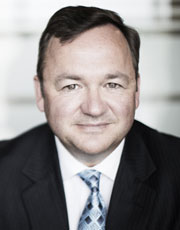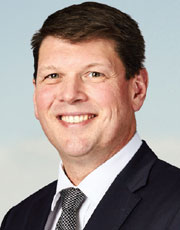In-depth interviews
As part of our study, we interviewed five CEOs of global utilities about their views and the direction of their business. Read below and gain more insights.

Barry V. Perry
CEO of Fortis
St. John’s, Newfoundland and Labrador, Canada
On the elements of basic strategy: Fortis’s strategy is centered on the growth of a diversified, regulated utility business across North America. This strategy is underpinned by several key themes and beliefs. These are the strength and value of North American assets compared with those of the rest of the world, a portfolio approach to managing the business, a strong focus on customers, an evolutionary rather than revolutionary development of the utility operating model, and an understanding of the strong investment opportunity available in meeting new required standards and ensuring the resilience and agility of electric and gas grids.
On plans for expansion: With simplicity in our operating model and an average 12 percent shareholder return for the last 20 years, Fortis has no plans to expand outside North America or to change its portfolio model throughout North America. Europe has made some big bets on transition (e.g., the renewables shift), and this has undermined value and confidence in the market with limited gain for customers (e.g., pricing). Similar experiences have occurred in other jurisdictions where ideological approaches to government policy or specific utility strategic reactions led to massive shifts that have not always delivered value. Fortis’s approach is a more measured, long-term focus because the utility industry is resilient. Fortis sees strong growth opportunity in its core transmission and distribution business, and in the introduction of renewables and cleaner energy into the grid, as well.
On evolving the model: The utility model, however, has a long way to go. Innovation, growth, and risk appetite are important and need to become part of the core culture of the business. A new way of thinking, as well as commercial and tech-savvy attributes and openness, will be required across the workforce. Creating opportunities for advancement for a new generation of customers is a focus. New revenue pools will be required, but compared to investment in the regulated business, we see it as, at maximum, 10 to 15 percent of the portfolio. Key areas of investment opportunity are electric vehicles and related infrastructure, batteries with renewables (wind/solar), and pumped storage. Fortis sees utility-scale renewables as more viable than distributed energy resources due to affordability and stranded asset cost implications. From a gas perspective, there is a big opportunity in Asia for coal replacement if the price is right. Additionally, the potential for liquefied natural gas export is large, with speed being the main consideration.
On the regulatory environment: Relationships with regulators are fundamental to utility success. Fortis operates in 17 jurisdictions, 10 of which have local regulators other than the Federal Energy Regulatory Commission. Fortis’s approach is to work collaboratively with regulators for the benefit of customers, honor the process, and be transparent. Fortis does not seek exemptions from regulation, but does seek to control its own destiny. Utilities and their investors should embrace regulation rather than seek exemption from it.
On growing consumer sophistication: Fortis believes change is inevitable in the industry. The challenge is the pace of change and not getting too far ahead. Customer engagement and technology will be an ongoing trend, and capabilities in this area will need to continue to evolve. Customer sophistication will keep improving, and it will continue to get easier for utilities to interact directly with their customers. Successful utilities will need to develop great customer relationships.
On emerging concerns: In the context of constantly changing industry expectations, Fortis is focused more than ever on its business strategy, capital allocation, and portfolio of assets. Fortis must remain competitive and anticipate these new industry and customer expectations in order to remain a leader in the sector and continue to increase shareholder value. Fortis also remains vigilant about safety throughout its group of utilities, about ensuring the resilience of the electric and gas grids, and about investment in cyber and physical security.

Scott Prochazka
CEO of CenterPoint Energy
Houston, Texas
On adopting strategy for a changing environment: CenterPoint Energy has been operating in a deregulated electricity market for almost 20 years, and has directly experienced the impacts of business segment unbundling and customer choice in energy supply. The company recognizes that the pace of change in the external market environment has been moving far faster than the industry has previously experienced, and that further change is accelerating in unpredictable directions. Consequently, CenterPoint Energy is designing its strategies to accomplish two primary outcomes: Invest in infrastructure to ensure safe, reliable, affordable, and environmentally responsible delivery of energy; and complement its regulated service with competitive products and services that more fully address its customers’ unique energy requirements.
On strategic priorities: For its regulated operations, CenterPoint Energy recognizes that success in its core business is fundamental to its long-term enterprise success. The company focuses on surpassing its operational, financial, and performance goals while identifying new, creative ways to be more effective and efficient. Though customers often demand solutions that require competitive, innovative solutions, CenterPoint Energy acknowledges the importance and value of traditional regulated energy delivery. This begins with operating and growing the current grid and natural gas delivery network in a safe and reliable manner.
At the same time, CenterPoint Energy believes that differentiation among its peers will be attained through unique and tailored energy delivery–related offerings and services that position it as the trusted energy delivery partner for customers. CenterPoint Energy’s competitive, nonregulated businesses include natural gas sales, energy-related services, energy performance contracting, sustainable infrastructure, and natural gas pipeline construction and repair services.
The competitive businesses are designed to advance CenterPoint Energy’s external visibility, creating clear market distinction, achieving an acknowledged level of leadership performance by key stakeholders — including markets, regulators, customers, and cities — and positioning the company for commercial success. With CenterPoint Energy’s market offerings and geographic footprint — the company has utility businesses in eight states and a competitive services footprint in nearly 40 states — the company has the potential to build a national brand across multiple business segments. This positioning extends beyond that of most utilities in the United States, which are typically only focused locally.
On responding to changing customer expectations: Customers are at the heart of CenterPoint Energy’s “Operate, Serve, Grow” strategy. The company recognizes customers are seeking energy solutions, in addition to traditional supply and delivery services. In the spirit of innovation, CenterPoint Energy is testing ideas that can be converted into commercial and operating applications. The company is expanding its capabilities to address the larger commercial and industrial sectors with solutions that integrate a blend of technologies, services, and energy management insights. Its product suite will broaden as its business expands and market-tested, technology-based solutions are adopted.
On building a culture of innovation: The company is aggressively working to embed a culture of innovation in order to expand and accelerate product development and enhance the value of the customer experience. It is increasing its focus on high-quality execution and adopting a value-delivery mind-set related to the work performed and relationships maintained with customers. Innovation is part of the daily conversation within CenterPoint Energy and a critical underpinning of its business strategy. The company is continuously engaging, challenging, and developing its employees, and it created an internal innovation incubator team to help new ideas move beyond pure concepts.
On the importance of challenging employees: Executing CenterPoint Energy’s strategy of regulated energy delivery and complementary competitive service offerings requires talent, capabilities, partnerships, and platforms. The company is working to emphasize the importance of “value creation” in employee performance. Emphasis is now placed on data analytics capabilities to provide predictive insights. CenterPoint Energy challenges its employees to invest time in understanding industry drivers and the changes to come. The company promotes a “Reject, Find, Drive” mind-set across all levels of the organization. To this end, all employees are encouraged to challenge (reject) the status quo and develop (find) new processes or approaches that solve problems and deliver (drive) differentiated service. CenterPoint Energy believes communications is critical to empowering employees as the company builds its capabilities as a comprehensive energy delivery solutions provider. The company’s goal is to ensure every employee is engaged, aligned with its vision and values, and understands how they contribute to long-term performance.

Brett Redman
CEO of AGL Energy
Sydney, Australia
On reinvesting in the company’s social license: AGL is one of three large Australian “gentailers” [generator-retailers]; we serve 3.6 million customers across both electricity and gas, and operate generation capacity of 10.6 GW.
AGL has three simple strategic priorities: growth, transformation, and social license.
Growth: We think about growth as meeting customer needs along three horizons:
- Optimizing our existing portfolio for performance and value
- Evolving and expanding our core energy market offerings
- Creating new opportunities with increasingly connected customers as data and energy value streams converge
Transformation: Building on AGL’s 180-year heritage, we must keep repositioning ourselves for the modern world. This means that our digital transformation will continue, and we’ll adopt and embed best-in-class technology and data analysis wherever we can.
Social license: Social license is about meeting and exceeding community expectations. Our ongoing investment in energy supply, our signing of the industry-led Energy Charter to drive better customer outcomes, our actions to support vulnerable customers, and our review of key customer and community commitments are integral to this. But we know there’s more we need to do.
On prioritizing strategic efforts: Our industry environment has changed — it is still a long-term industry, but governments and customers are thinking more in terms of months and weeks. Executing our strategy in a way that balances these long- and short-term needs is not new, but succeeding in this environment today is much tougher than it used to be.
On changing consumer expectations: We have seen a marked shift in consumer expectations over recent times on how we should act and behave in the market. Building customer advocacy is the most important arm of our strategy. Changes in community expectations and the ongoing importance of companies continuously “reinvesting” in their social license to operate are fundamental to how AGL thinks about the communities it operates within and the customers it serves. This is about much more than just loyalty. The biggest risk to us is losing trust with the community and our customers. If we lose trust, customers will look elsewhere, and this can give innovators a leg up with a new and shiny offering.
On dealing with technology disruption: AGL is a fast follower, not a product developer. We have strong capabilities in helping our customers make good choices and putting in place the supporting systems and processes.
On applying data to the business: Technological change and the rapid improvements in unit costs of new technologies, such as battery storage, provides great opportunities for AGL to both improve customer service and help manage the transition to lower-emission technologies. If we get this right, this is a massive opportunity for AGL. We are investing in customer data capabilities and will make changes to our business model, but only where it will create products and services that customers will value. Cleverly using generation plant data will help us improve the reliability of our generation plant, which is increasingly important as some of our older units are heading toward retirement.
On dealing with competition: We focus on what we can control, and on how we get best value from our capabilities and assets for our customers and our shareholders. We fear the innovator who changes the conversation. We manage the wholesale risk of our trading book very carefully, and we see this as a strategic buffer at this stage.
On engaging employees: We are building on our values, we use stories to bring our strategy to life, and we invest in the people capabilities that will differentiate us in the market. Losing great people is our second-biggest strategic risk.

Francesco Starace
CEO and General Manager of Enel
Rome, Italy
On Enel’s strategy: Our strategy can easily be summarized as follows: We create value in a sustainable way, because that is the only way to ensure the long-term life of the company and to progressively de-risk our earnings profile going forward.
We went through two phases of strategic thinking. The initial one, in 2014–15, focused on defining the main drivers along which we wanted to deploy our strategies and on identifying areas that we no longer wanted to focus on. For example, we stopped thinking about growth investments that take more than three years to go live and whose returns are exposed to the volatility of energy prices. At the same time, consensus from the communities that live and work around our infrastructure became a key element informing our way of doing business. If we don’t have this consensus, we avoid carrying out new investments, even if we have all of the permits for them.
In the second phase, we put renewables at the heart of Enel’s development strategy. We saw that we were spending about 60 percent of our capital to maintain assets that we had and 40 percent on adding new assets, revealing both inefficiency and a lack of ambition. Therefore, we set a goal of reversing the proportion, shifting investments toward new renewable capacity and thus creating more value for our shareholders. Eventually, we made a profound change to our internal organization. We decided to allocate the responsibility of retail activities and cash flow generation to regional units, because our customers’ habits change from one country to another, and so do languages, tax treatments, and regulation. At the same time, we created several centralized business lines in charge of driving growth, investing cash flows, and dealing with the technological aspect of our businesses: networks, thermal generation, and renewable generation. Then we identified about 250 people who, working at the intersection between these two dimensions of our organizational matrix (the regional units and the centralized business lines), had the intellectual flexibility to manage them and understand the trade-off between them.
On addressing market and technology disruption:: The transition that is shaping our sector is driven by two main trends. The first one is digitization, which is changing the way we build and manage our assets, and the way our customers relate to us. The second is the continuous evolution of material science, which allows the components in our plants to become lighter, cheaper, more durable, and more efficient. We’ve understood the magnitude of these changes for some time. Indeed, 10 years ago, we were among the first to believe that renewables were going to be the cheapest electricity source, and so we built our growth strategy around them. At that time, we understood that a massive renewables penetration poses challenges to traditional network operations, and so we started digitizing them. Eventually, drawing on our experience in smart grids, we decided to digitize our generation fleet and customer operations to enhance their flexibility and efficiency.
On value-chain positioning: Given the extent of the ongoing energy transition — of which we can guess the direction but not predict the exact outcome — we chose to keep an integrated position along the value chain to increase our resilience and value-creation opportunities. Moreover, we decided to be present in multiple geographies, where energy transformation is occurring at different paces. This allowed us to anticipate some trends in less advanced electricity systems and, coupled with commonly available IT platforms, gave us the chance to replicate good practices and innovations, scaling up their benefits quickly across countries.
On growing new businesses: The Enel organization, designed along the aforementioned business lines, has worked to streamline processes, increase efficiency, and manage investments for its traditional businesses. But there are many new opportunities that are difficult to develop within units devoted to legacy businesses. So we created a new business line called Enel X, and gave it a strategic mission to develop new B2C, B2B, and B2G services, including electric mobility, energy efficiency, demand response and storage, public lighting, distributed generation, and fiber optics. Aside from achieving proper momentum and accountability on these new activities, this reorganization allowed the traditional business lines to focus on their core activities, thus achieving additional efficiencies.
On competitive pressures: We feel the most important competition in our sector is not the one among utilities, but rather the one between electricity and fossil fuels. Indeed, our aim is to make electricity the preferred energy source for residential, commercial, and industrial applications, displacing the use of gas, coal, and oil. This will be possible thanks to renewables, which will increasingly provide cleaner and more affordable electricity to residential houses and businesses.
On competitive threats: Instead of threats, we see consistent factors of instability from regulatory, political, and financial standpoints, and an accelerating technological disruption. Regarding regulatory, political, and financial factors: Aside from maintaining cooperative relationships with our stakeholders, the only mitigating factor for such inherent volatility is the geographical diversification of our businesses. For example, we have eight distribution networks all over the world, and regulatory cycles last three to four years. So each year, we face just one or two regulatory updates, and that makes our economic results more predictable. With regard to the challenges caused by the technological innovations, we believe they could turn into new opportunities, provided we stay open to new ideas and share knowledge with customers, suppliers, and all of our stakeholders.

Dr. Johannes Teyssen
CEO of E.ON
Essen, Germany
On the goal of strategy: Strategy is a plan to achieve defined business objectives under uncertainty. Strategy shapes the future and direction of our company and thus gives us guidance and purpose. A strategy must go down to the business and, most importantly, must be actionable. Capital and talents to achieve our business objectives are always constrained, so we need to prioritize. For this, we need to fully understand and develop a view on the future market environment as well as internal capabilities.
On key strategic priorities: With our strategy, we aim to add value in all our businesses by allocating scarce resources to businesses that provide specific opportunities to our customers, are scalable, and can thus deliver value and growth for our investors. In operations we need to deliver outstanding performance and putting our customers at the center of everything we do. So, how do we differentiate? In the traditional utility business, companies operate with long payback times and face a world in which the clock speed is increasing. My view is that in such an environment, you must focus your business and thus provide certainty, while also retaining a needed level of flexibility. This is how our strategy differentiates us.
On addressing market and technology disruption: We can all see that the electricity sector is transforming rapidly. We see that customers and societies demand a more sustainable, de-carbonized, and independent energy world. Costs for renewables and energy storage are falling rapidly, and in general it looks like technological progress is accelerating. We need to bring renewable power efficiently into the hands of our customers to provide for electric mobility and green heating and cooling. The integration of renewables energy needs to be organized as local as possible to avoid losses and waste. These developments will enable a new energy world. And this future energy world will be more electrical, more distributed, and smarter than today. Already we can see that the vast majority of new renewable installation is connected on the local level to our energy networks, forming a customer-centric future.
We made one of the most radical strategic moves one can think of: In 2016 we split our company. With the split, we broke the value chain apart. We established two independent companies: Uniper, with a focus on conventional, large-scale generation, and the new E.ON, with a focus on renewable generation, energy networks, and customer solutions. Our strategy thus focuses our company systematically on the substantial growth opportunities with the evolving energy world. The approaching acquisition of [Germany-based] Innogy and the handover of our renewables business to RWE helps us to put an even stronger focus on our downstream business. This next step will help both companies — the new E.ON and RWE — to get the necessary scale to grow in our respective areas.
On the impact of competitors on strategy: We can see that new competitors emerge by entering the electricity sector — oil and gas majors on the one side, and data-driven companies on the other. Thus, competition will stay intense and only players with clear competitive advantage in the individual market segments will be able to win. This implies that we need a stringent operational translation of our strategic choices into execution to be able to succeed. This is reflected in the recent change of our setup from a regional geographic and more centralized structure into a rather local and divisional structure. This includes many more business-led structures and accountabilities, the introduction of more agile and lean methods of working, and a radical Net Promoter Score orientation. This brings our board closer to the business and allows us to be much faster and proactive regarding changes to our business environment.
On the threat to strategy: The energy world will continue to change and, as mentioned before, the clock speed is increasing. We certainly need to be flexible and develop clear views on trends, market, and policy developments, new technologies, etc. All these developments could significantly threat the execution of our strategy, as they have in the past. It is therefore crucial that we quickly build the required capabilities and create a company culture and organization that is consistently customer-obsessed, digital, and agile.
On enlisting employees on the strategic journey: For me, it is of utmost importance that our strategy provides our employees a clear purpose and direction, the attraction to work at the forefront of building the future energy world, and attractive development opportunities. As in any change process, communication is key. Our new setup allows us to communicate [in a way that is] targeted to the needs and requirements of our employees in diverse divisions and countries. This includes traditional elements like townhall meetings but also blog posts and videos on our internal Facebook-like intranet. But there is more we can and have to do, especially regarding the integration of Innogy. Our people do not need to be able to robotically repeat the details of our strategy or list our core values perfectly and quote our vision. But they should understand and strongly identify with our purpose, and they should implicitly understand the nature of our character and be part of that progression. And with that, they should really understand our direction. Of course, this development of internal motivation is far harder than only communicating the strategy, and it will be a long journey for us — but it will reap far greater rewards.
Contact us

Global Energy, Utilities and Resources Leader, Partner, PwC Netherlands
Tel: +31-88-7921328





